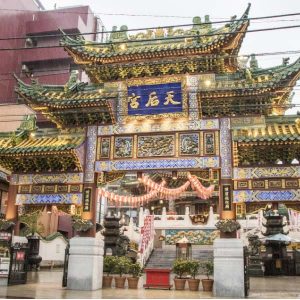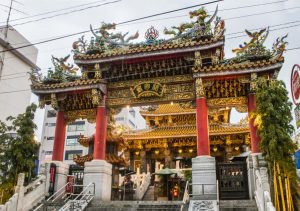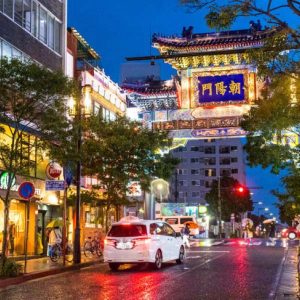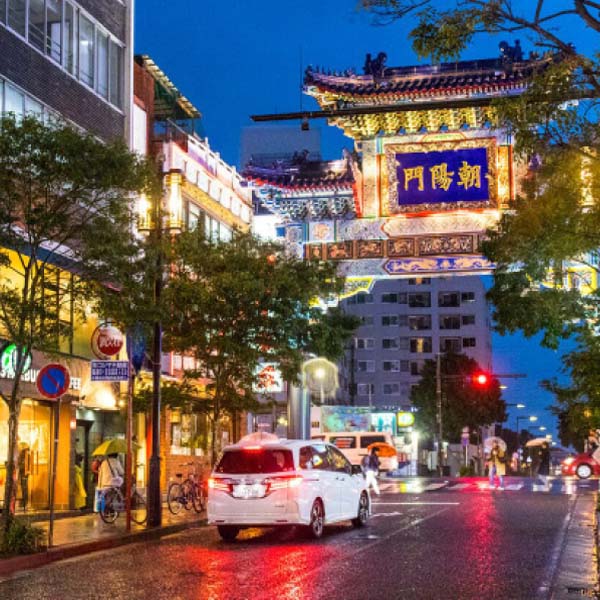
Growing up in Binondo, I always wondered about other Overseas Chinese communities. What fascinates me is the integration process – how they combine their culture with that of the country they now call home. So, whenever I visit a country that has a Chinatown, I check it out.
When I visited Japan this year, I decided to explore their biggest Chinatown, which is located in Yokohama, Japan’s second largest city. I wanted to find out how the Chinese community started and how it managed to survive despite the difficult political tensions between Japan and China, especially during the 20th century.
The Chinese and Japanese have been traveling to each other’s countries for centuries. But it wasn’t until the 1600s that the first Chinatown was recognized in Japan, in the port city of Nagasaki. The reason: Japan had entered into a period of isolation during that period. The government decided to cut itself off from the rest of the world. Foreign trade was only allowed in Nagasaki.

But as with Manila’s Parian, the Chinese’s movements were strictly monitored and they were discouraged from socializing with the locals. A Chinese trader could be arrested if he was found outside of Chinatown at certain times.
It wasn’t until the mid-1850s that Japan reconnected with the outside world. More Japanese ports were opened up to foreign trade, among them Yokohama.
As European and American traders came to trade with Japan, there was a growing need for translators and middlemen. The Chinese proved to be eminently suited for the role, as they were able to communicate effectively with the Japanese through writing.
This paved the way for more Chinese to go to Japan and work as carpenters, tailors and cooks. Thus, the growing Chinese community led to the establishment of Yokohama’s Chinatown in 1859.

In 1899, the restrictions on foreign settlements from expanding around Yokohama were eased. The community soon became the biggest Chinatown in Japan, covering an area of 10 city blocks.
But unlike Chinatowns in Southeast Asia, where trading and commerce are the source of its identity and economy, Yokohama’s Chinatown’s source of identity comes from dining – mainly due to the fact that many of the restaurants in the area were actually owned by Japanese.
They helped adapt Chinese cuisine to Japanese taste, and was popular among a wide segment of Japanese society. This helped raise the image not only of Yokohama’s Chinatown but the city as well.
Yokohama’s Chinatown was deeply affected by the Great Kanto earthquake, also known as the Tokyo-Yokohama earthquake of 1923. The damage from this natural disaster was the greatest sustained by prewar Japan, and resulted in many Chinese residents fleeing back to China.
In 1937, Chinatown’s growth went into further decline when Japan invaded China. It wasn’t until after the war that the redevelopment of Chinatown resumed.
In 1955, Yokohama’s city government built a goodwill gate in Chinatown in recognition of its contribution to the city’s economy and identity.
It was late afternoon when I arrived at the subway station nearest to Chinatown, the Motomachi Station. Even under a cloudy sky, Yokohama’s Chinatown was colorful and picturesque.
Its narrow streets were bright with colorful pagoda-style roofs, neon lights, red paper lanterns and bright gold and red signage. It was a bit over the top, and gave an impression of a theme park.
This tendency for ornateness extended to the interiors of some of the retail outlets and eateries. Some have so many gold gilded ceilings and elaborate carvings that they could be mistaken for a temple.
There doesn’t seem to be a lot of old buildings, but given the destruction it faced in the past, it is not surprising.
Walking along Yokohama’s Chinatown doesn’t feel like you are walking around Shanghai, Suzhou or Shenzhen. This is because the Japanese component of Yokohama’s Chinatown is still very much in evidence. You see it in the use of Kanji (Japanese written characters) in the signage and the use of plastic food models in the window display of restaurant.
To learn more about how these two cultures blended together, I went to one of the area’s busiest streets, Chukagai Odori. My goal: sample a few familiar Chinese food and see how it was made more appealing to the Japanese.
At a food counter, I tried the Japanese version of the siopao and siomai. My initial reaction was there seemed to be more emphasis on appearance than on flavor.
The siomai looks and tastes similar to those in Binondo’s Mazuki and Lingnam. And while they did nothing to change the siomai’s appearance or taste, it was served in a cardboard box wrapped with shiny printed paper, with a small blue and white ceramic bottle inside the box that turned out to be the soy sauce container.
This is the Japanese concept of marketing: the more shop owners and businessmen do to make their customers feel special, the more the customers are willing to buy. Of course, all these extras come at a price. A box of six siomai comes at ¥680 or roughly P340.
As with every Chinatown I visited, I wanted to explore more and connect in a deeper way. I wanted a glimpse of the community apart from its business commerce or food.
I decided to visit two Chinese temples in the neighborhood: Masobyo and Kanteibyo.
Masobyo, the newer of the two, is located on the lower end of Minami-mon Silk Street. Also known as Mazu Miao Temple, it is dedicated to Mazu (媽祖), who is also known as Ma-tsu or Ma-cho among Tsinoys. She is the Chinese goddess or patron of seafarers and sailors.
This temple structure is just a decade old as it opened only in 2006. But according to the temple’s tour brochure, the statue of Mazu was housed in another building on the same location for 140 years. But the building was marked for demolition and the lot was going to be redeveloped into an apartment.
This motivated the local devotees of Mazu to raise funds to buy the land and have a temple built. Evidently, the devotees succeded.
The temple is open free to the public. But if you wish to light an incense stick, you need to buy a ¥500 ticket at the entrance. This will entitle you to five incense sticks, which you then place individually among five incense burners.
Only then will you be allowed to enter the temple itself and have an audience with Mazu and her two guardian generals. But even if you don’t perform this, you can still stand at the entrance of the temple and witness its lavish interiors.
I was hoping to meet members of the local Chinese community at Masobyo. But probably because of the rain and cold, I encountered only tourists and the temple staff there. I asked one of the Chinese speaking temple volunteers if she was a local. Alas, no – she was a recent migrant from Taiwan.
I went back up Minami-mon Silk Street and turned left into Kanteibyo Road. The street is named after the temple located there, and is probably the oldest and most revered part among the residents of Yokohama’s Chinatown.
In 1862 a Chinese migrant brought a statue of Guan Gong (關公/闗羽, Dharma protecting diety, god of war, door god) from China and housed it in a modest temple. As more and more Chinese became its devotees, it became a major landmark of Yokohama’s Chinatown.
However, the temple that now stands on this road is not the one originally built in 1862. That former temple was destroyed during the great 1923 earthquake.
The next temple built suffered extensive damage during air raids in 1945. After the war, the temple caught fire twice in the 1980s. But every time the temple was destroyed, Yokohama’s Chinese community rallied to have it rebuilt. Each time a newer temple was rebuilt, a more elaborate structure resulted. This current temple was completed in 2000.
I climbed up to the main temple where Guan Gong statue is housed. As with Masobyo, I just stood outside by the door and gazed at the richly ornamented interiors.
The temple’s brochure mentions that aside from Guan Gong, there were several other deities such as the Guan Yin.
However, I don’t recall if Guan Gong’s horse was there as well as is the practice with Guan Gong’s temples in Manila.
Though it was the center of Yokohama’s Chinese community, there weren’t many locals around that rainy afternoon.
But from the temple, I spotted the Yokohama Overseas Chinese School next door. But since it was in the middle of the spring break in Japan, the school was empty. I later read that Sun Yet Sen established this school in 1898. However, in 1952, the school was split into two institutions.
One of them, the Yokohama Yamate Chinese School, chose to align itself with the government in Mainland China. The other kept the original name and formed an alliance with the government in Taiwan.
Indeed, it is hard to detect signs of an active Chinese community here. One reason for this is its population. Despite being Japan’s biggest Chinatown, it has an estimated population of only around 6,000 Chinese residents. This is a mere 0.01 percent of the entire ethnic Chinese population in Japan, which currently stands at 687,156. Compare this on a national level with the rest of Japan’s population, the Chinese community comprises only 0.53 percent of the country’s population.
But the Chinese population in Japan has been rising steadily in the last 20 years. The number has already risen three-fold since 1995, when the ethnic Chinese population then was much lower at 222,992.
The population boom was partly due to the influx of university students studying in Japan. Some graduates opted to stay on in Japan and found work in the country’s technology sector.
This created a gap with members of the older community as many of them work either in the trading or in catering sector. This means that I probably would have better luck meeting members of the local Chinese community at a university or at an information technology firm than here in Yokohama’s Chinatown.
Despite not being able to connect with the local Chinese community, I still felt that my time in Yokohama’s Chinatown was not wasted. I was able to get a glimpse of what must be one of the prettiest Chinatowns I have visited. This Chinatown has proven that the Chinese and Japanese need not be hostile to each other. Our two cultures can look beyond our differences and create things that can benefit people and co-exist in harmony.
